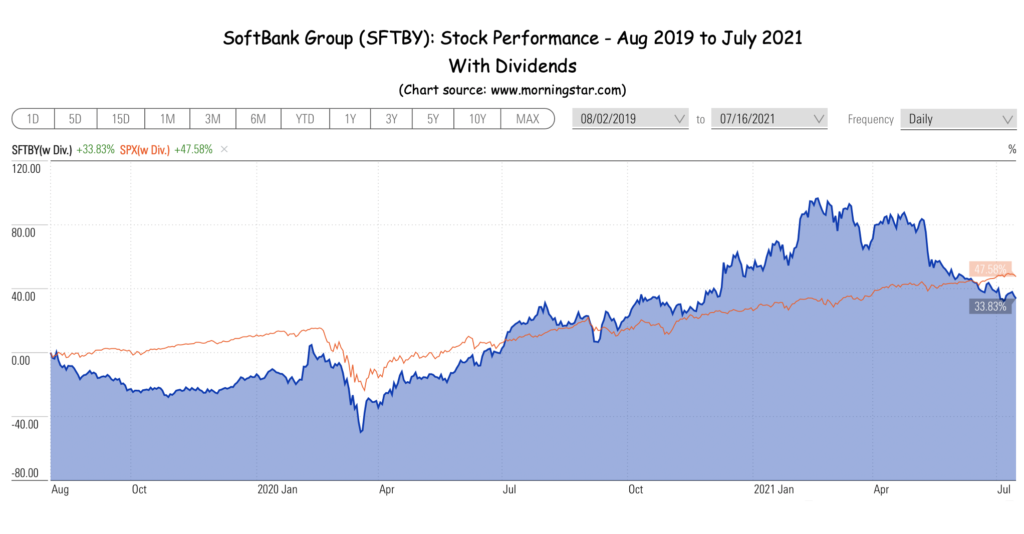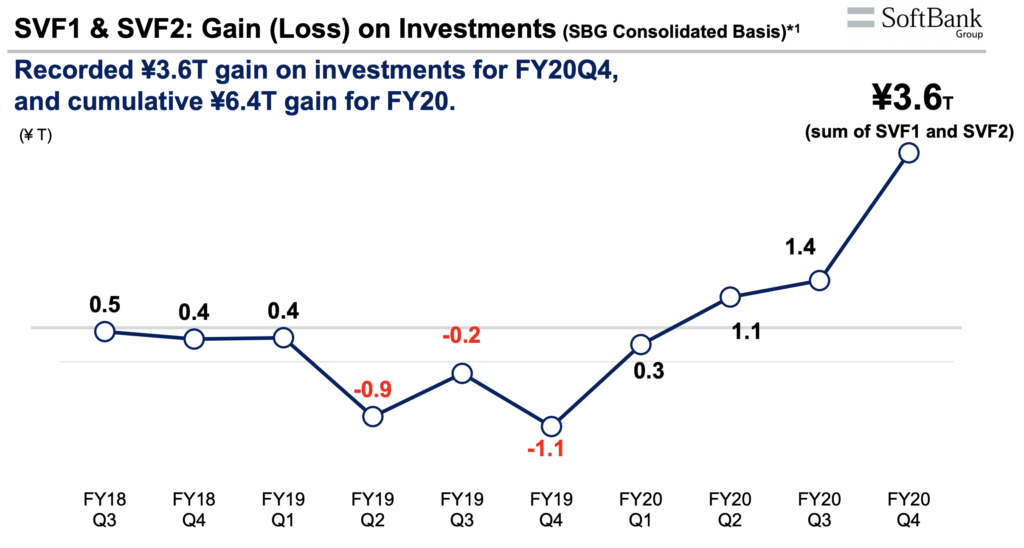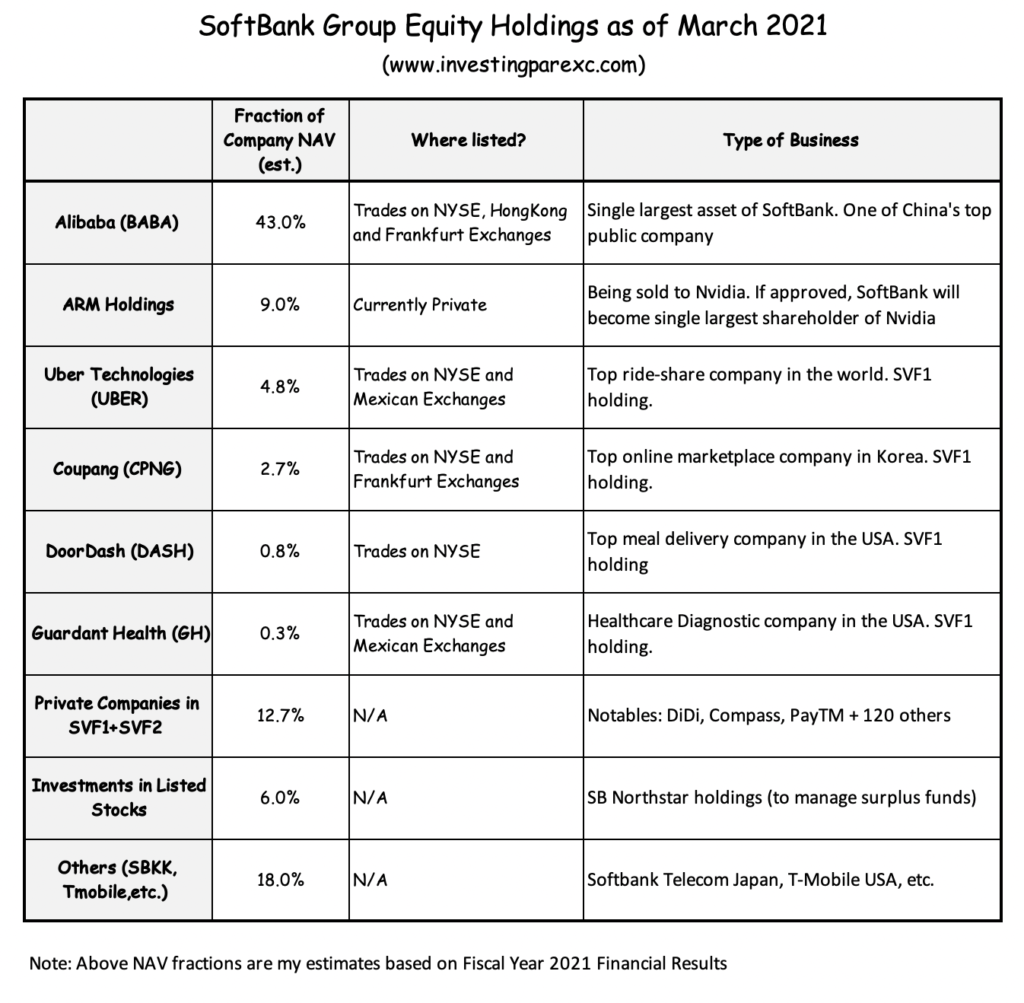
SoftBank is an enigma for me. On one hand, it has all the traits of an excellent owner-founder run business—the kind that I love to invest in. On the other hand, some of its management’s recent moves have spectacularly failed, making me think twice before investing again.
As I noted in an August 2019 blog post (Investing in startups through Softbank), I took a small position in it two years ago. My investing thesis was based on its long-term oriented, very-high-ownership founder/CEO who also had an excellent record of investing in tech disruptors. Combined with great valuation at the time and the prospects of indirectly participating in venture-capital (VC) investments, SoftBank was an attractive buy for me. Read that post for my detailed thoughts on SoftBank.
In this post, I will look into how the business has fared in the last two years, and do I still believe in its prospects. First, let’s look at how the stock has performed since I bought it in August 2019.

Clearly SoftBank stock (SFTBY) has been much more volatile than the S&P 500 index (not entirely unexpected though). For the first 12 months, SFTBY mostly stayed below my cost basis, at one point in March 2020 dipping 50% below amid the pandemic shock. It did recover and eventually rose to twice what I paid for in February this year. Since then, it has been trending downhill.
As of today (July 16), my 2-year return is about 34%, dividends included. The S&P 500 index did better during the period, notching 47% comparable return.
I don’t buy or sell stocks based on their two-year performances. Relative performance with the overall stock market is of interest, but also not a major factor in my keeping a position. The above chart is interesting but, in the end, inconsequential. I am far more interested in understanding how SoftBank as a business entity has been doing.
How the business fared? The last two years were a mixed bag. SoftBank had some missteps late in 2019 and early 2020. But it recovered and did well in the latter half of 2020.
First, the negatives: Some of the SoftBank’s headline grabbing investments did not do well before and during the pandemic. Foremost among them was WeWork. WeWork IPO collapsed in late 2019, even before the pandemic hit, as its business model crumbled. Then Softbank became entangled in two of the Europe’s biggest corporate scandals in recent times: Wirecard and Greensill. Though the resulting damage to SoftBank was fairly limited in financial terms.
I mentioned in that 2019 blog post that SoftBank had reputational risk. Well, it did materialize due to these and some other smaller failed investments. So much so that it could not raise any outside capital for its second flagship fund, Softbank Vision Fund 2 (SVF2). SoftBank went ahead with SVF2 with entirely its own capital.
In the spring of 2020, future of many tech startups—that Softbank had invested in—had looked rather bleak. Pandemic had hurt their valuations and SoftBank had to write down its holdings. Also its corporate bond yields surged over concerns that perhaps it has taken too much debt.
The positives: Then as global economies rebounded in the second half of 2020, SoftBank, along with its many tech investments, also recovered. Management sold off some of its $250B+ assets to raise cash. It IPOed its Japanese telecom subsidiary, SoftBank Telecom Corp. It sold a small portion of its huge Alibaba (BABA) stake. It also sold its Sprint stake to T-Mobile (but retained some shares). All in all, it raised just over $60 billion to shore up its balance sheet and buy back own shares.
And that’s the other thing that SoftBank did very well i.e. return capital to its shareholders. In 2020, it doubled its dividend per share. It also completed three major share buybacks in 2020 and 2021—worth about 2 trillion yens—at the time when the share price was low. It wasn’t a surprise that the shares went up each time a new buyback was announced.
Looking past the major duds like WeWork, Softbank as an investor has done quite well since the pandemic recovery began. Its two flagship funds, SoftBank Vision Funds 1 and 2 (SVF1 and SVF2) have a combined net IRR of 39% since inception. SVF1, the older fund, has had several successful exits this year. SoftBank’s own stake in SVF1 has increased to 50%+ as it began to return outside capital after investment exits. SVF1 has some excellent listings (via IPOs and SPACs) and exits in the last 24 months, such as Slack, Coupang, DoorDash, OpenDoor, and Qualtrics.

When I wrote that blog post two years ago, I said I was hopeful that it was just my first transaction with more to come as I better understand this business. Well, I didn’t add to my position for the following two years. At its peak in the first quarter, the stock had doubled from my original investment. Since then, it has trended lower. Today, it is selling at a good discount to its intrinsic value, so I decided to double my position. This is my second helping and it comes after a volatile two-year period where the stock was cut in half, doubled, and then went down some again.
Two big motivations for my buy decision today are: (1) The company is once again selling at a discount whereas the CEO has increased his personal stake in it. (2) It continues to own some good businesses that I don’t otherwise have in my portfolio.
CEO Ownership: All through the last two turbulent years, Masayoshi Son, the founder CEO has stayed loyal to the company. He has not sold a single share. In March 2019, his personal stake in SoftBank was at 22%. Two years later, his stake has now increased to 26.5%. All due to aggressive share buybacks by the company. By most accounts, Masa-san’s personal net worth is all tied up in his company’s common shares. I love this. He is in this together with all the other shareholders.
Major Investments: I wrote in 2019 that I was investing in tech startups indirectly via SoftBank. It is still true today. The company owns shares in some promising startups (120+ different names). Or at least I hope so. I don’t spend time researching private companies, so I don’t know this for sure.
But besides private startups, SoftBank also owns shares in high-quality public companies that I don’t have in my portfolio. Names such as Alibaba (BABA), ARM (now private), Uber (UBER), DoorDash (DASH) etc. I’ve put together this table to show major portfolio companies that SoftBank today either owns directly or via its investment funds:

None of these companies are in my portfolio today. This way, SoftBank is a nice compliment to my other holdings. Alibaba is still its largest holding, though it is a smaller fraction today than in 2019. Its share in private tech startups itself is worth more than 12% of the total NAV. ARM Holdings is another intriguing position. If SoftBank could successfully navigate around antitrust issues, it may become the largest outside shareholder of Nvidia (NVDA)—a high-quality owner-driven company that I have never owned in my portfolio.
Today my stake in SoftBank is still small relative to my other holdings. Though I plan to hold and possibly increase my ownership over time. Last two years have been quite turbulent for SoftBank. None too surprising given that it was transforming itself from an operational company to an investment holding business. I believe it has fared quite well through the rough 2020 (notwithstanding all too frequent negative press coverage) and thus my increased confidence in it. Still, SoftBank’s future performance will be mostly dependent on its founder’s investing savvy and growth of the tech VC industry. It will be an interesting ride. I will continue to tag along.
Leave a Reply